Gigabyte GeForce RTX 2070 Windforce review: This $500 graphics card is a solid value - reddanstivoung

Brad Chacos/IDG

At a Glance
Expert's Rating
Pros
- Great 1440p and entry-level 4K gambling performance
- RT and tensor cores for ray tracing, DLSS, and more
- Custom Windforce cooler is better than Nvidia's Founders Edition
- Actually achieves $500 MSRP price
- Similar performance to pricier RTX 2070 options
Cons
- Ray of light trace and DLSS not available in games yet
- Plastic sheet and fans
- Lacks fancy extra features
Our Verdict
With the Gigabyte RTX 2070 Windforce delivering such strong performance at $500, there's little reason to spend more on an RTX 2070 graphics card unless you're look for specific features.
Best Prices Today

$859.00
The Gigabyte RTX 2070 Windforce is a member of a small and alone club: A GeForce RTX graphics wit that actually sells for Nvidia's MSRP!
Yes, GB's GPU costs $500 at Amazon, a full-of-the-moon $100 less than Nvidia's own RTX 2070 Founders Variant. The wag skips kayoed happening fancy touches to accomplish its price point; You South Korean won't find fancy metal shrouds operating room factory overclocking Here. But the GB RTX 2070 Windforce does offer carrying out just about along a par with pricier RTX 2070 options, plus with a triple-fan tank that's Thomas More effective than the chilling in Nvidia's Founders Edition, whol delivered at a monetary value that actually makes the graphics posting a compelling option versus the terminal-gen GTX 1080. Applying an overclock to get more performance couldn't be quicker or easier, either.
It's hard to call a $500 artwork card a good value, merely when IT comes to RTX 2070 options, G's Windforce fits the bill. Lashkar-e-Taiba's dig in.
G RTX 2070 Windforce glasses, features, and price
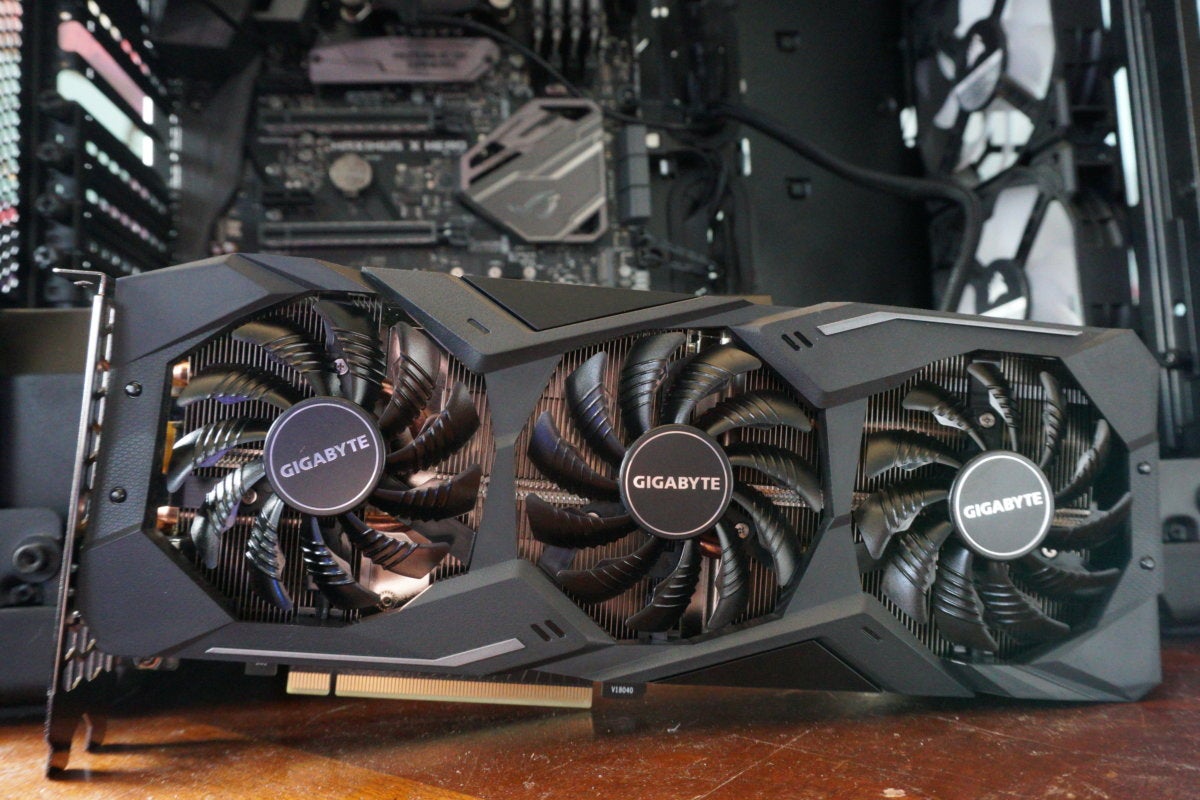 Brad Chacos/IDG
Brad Chacos/IDG Unlike the $600 Nvidia RTX 2070 Founders Edition and EVGA's $550 RTX 2070 Cardinal, the G RTX 2070 Windforce doesn't ship with a factory overclock. Under the hood, this card sticks to the RTX 2070 GPU's quotation specs:
- CUDA cores:2,304
- Time speed: 1,410MHz base, 1,620MHz boost
- RT cores: 36
- Tensor cores: 288
- Texture units: 144
- ROP units: 64
- Memory capacity:8GB GDDR6
- Memory path:256 bits
- Remembering bandwidth:448GBps
- Ports:1x VirtualLink/USB-C, 3x DisplayPort 1.4, 1x HDMI 2.0b
- Big businessman:1 6-immobilize, one 8-pin, 550W+ power supply required
- Price: $500
That level of hardware bequeath get you fantabulous 1440p gaming performance, and even entry-level 4K gambling, atomic number 3 you'll see in our benchmarks later. But the big draw for Nvidia's RTX GPUs is the inclusion of dedicated RT and tensor core computer hardware for greatly enhanced performance in time period ray tracing and machine learning-enhanced tasks such as Deep Level Super Sample distribution.
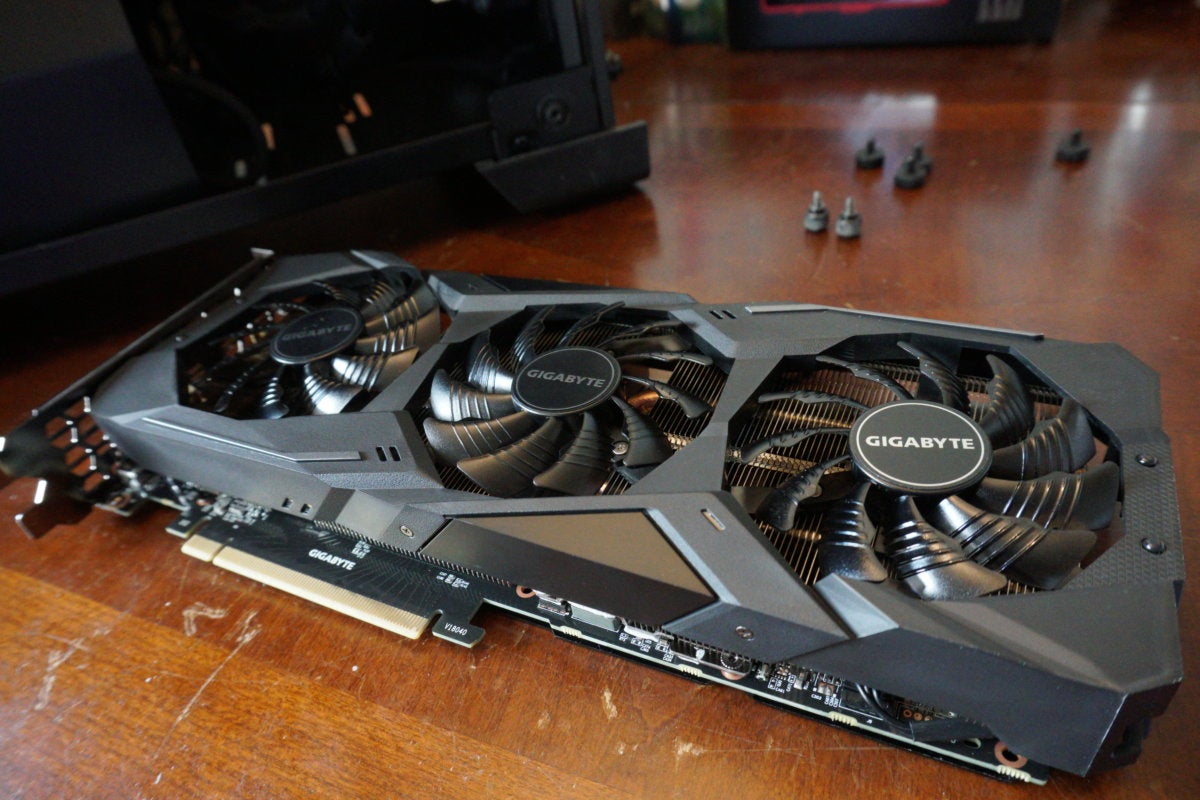 Brad Chacos/IDG
Brad Chacos/IDG At least in theory. In reality, no ray derived Oregon DLSS-enhanced games have hit the streets yet, even though the front RTX GPUs launched in middle-September. Scads of games have pledged to support beam of light tracing OR DLSS, but if you buy a RTX 2070 today, all you can do is hope that those features wish prove as impressive as Nvidia's marketing claims. You seat learn Sir Thomas More almost ray tracing and DLSS in our deep-dive into the Nvidia Alan Mathison Turin GPU besides as the prospective tech section of our RTX 2080 and 2080 Ti review, where we examined some preserved demoes provided away Nvidia.
Contempt carrying a rock-bottom price tag, Gigabyte outfitted the RTX 2070 Windforce with a bespoke cooling solution that gives the card its bring up. Three fans sit atop the plug-in's constructive tack, with the middle buff spinning in the opposite direction of the outer blades to ostensibly create smoother air flow for finer heat waste. The fan blades themselves are plastic and feel fragile when prodded, though, peculiarly compared to the hard-boiled blades on the Nvidia Founders Edition and EVGA RTX 2070 XC. Those blades grind to a stoppag when you aren't gaming or other stressing the GPU, spurting inaudible during traditional desktop use—always a much-gratifying feature, and one the Founders Variant sorely misses.
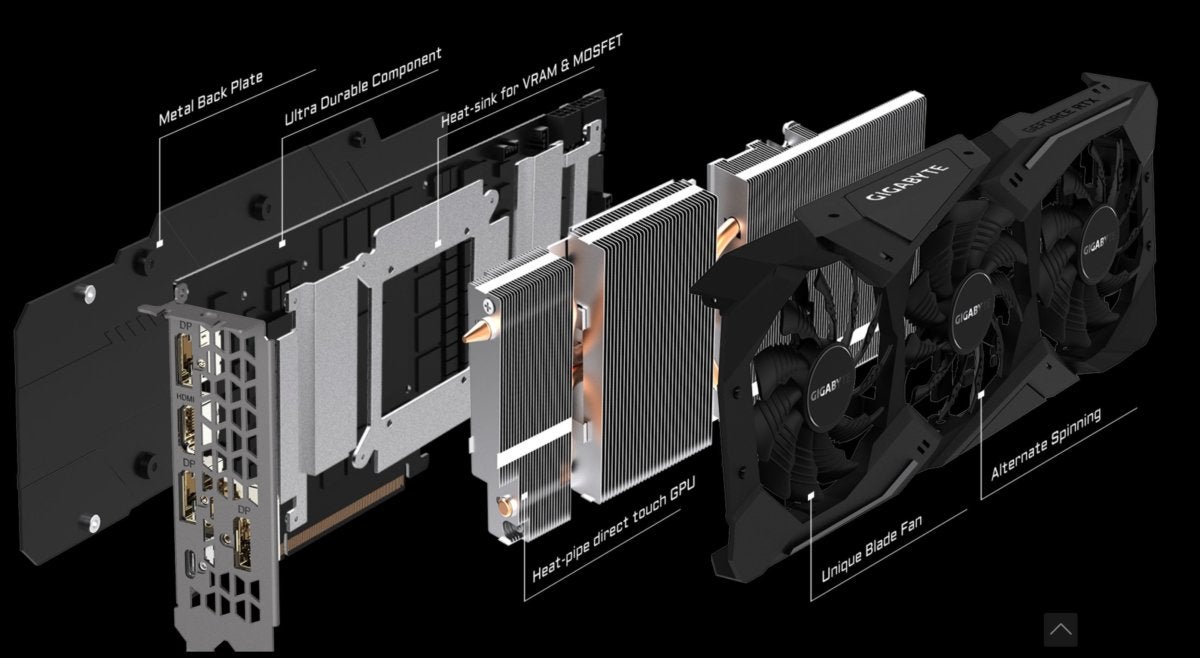 GB
GB A deeper look at Gigabyte's Windforce cooling system.
A rich-length heat sink sits underneath the shroud, increased aside a pair of copper composite heat pipes that directly touch the GPU for best heat transfer. Underneath that, a large metal plate helps move heat outside from the card's computer storage and MOSFETs, and Gigabyte ace the package off with a metal backplate emblazoned with the party's logo. You'll observe another GB logotype on the edge of the card, only that one's infused with RGB LED lights that you can customize with Gigabyte's Aorus Engine software.
It's a Thomas More effective cooling root than the one in Nvidia's pricier RTX 2070 Founders Variation, as you'll see in our temperature benchmarks. Speaking of which, that's enough verbal description. Let's head to the test Bench!
Next page: Our test organisation.
Our test system
Our ordained graphics card test system is with many of the fastest complementary components usable to put any potential performance bottlenecks forthrightly on the GPU. Most of the hardware was provided by the manufacturers, merely we purchased the tank and storage ourselves.
- Intel Core i7-8700K processor ($360 on Virago)
- EVGA CLC 240 closed-loop liquid cooler ($120 on Amazon)
- Asus Maximus X Hero motherboard ($260 on Amazon)
- 64GB HyperX Predator RGB DDR4/2933 ($416 for 32GB on Amazon)
- EVGA 1200W SuperNova P2 power provide ($180 on Amazon)
- Corsair Crystal 570X RGB character, with front and top panels removed and an extra rear fan installed for improved airflow ($170 on Virago)
- 2x 500GB Samsung 860 EVO SSDs ($100 on Amazon)
We're comparing the Gigabyte RTX 2070 Windforce ($500 on Amazon) against the Nvidia GeForce RTX 2070 Founders Edition ($600 at Best Buy out and GeForce.com) and EVGA RTX 2070 Cardinal ($550 happening Newegg). We're also showing how it compares against the step-upfield GeForce RTX 2080 Founders Edition ($799 at Best Buy in or GeForce.com) and last coevals's GeForce GTX 1070 Founders Edition, GeForce GTX 1080 Founders Edition, and PNY GeForce GTX 1080 Ti. We've also included results from the Radeon RX Vega 64 reference card, AMD's GTX 1080 rival.
Each game is tested using its in-game bench mark at the highest possible nontextual matter presets, with VSync, frame pace caps, and all GPU vendor-specific technologies—like AMD TressFX, Nvidia GameWorks options, and FreeSync/G-Sync—disabled, and temporal anti-aliasing (TAA) enabled to push these high-end card game to their limits. If anything differs from that, we'll mention it.
The RTX 2070's performance is firmly established at this maneuver, and while the Gigabyte Windforce version isn't overclocked, IT still hangs close to the Nvidia Founders Edition and EVGA RTX 2070 XC, even though they ship mildly faster from the mill. Because of that, we'll be showing our gaming benchmarks without any additive meta-commentary until the stopping point of this while.
G RTX 2070 Windforce performance benchmarks
Strange Brigade
Lease's kick back things turned with Strange Brigade ($50 on Humble), a cooperative third base-individual shooter where a team of adventurers flak through hordes of mythological enemies. It's a technological display case, built approximately the next-gen Vulkan and DirectX 12 technologies and infused with features like HDR support and the ability to toggle asynchronous compute on and off. It uses Rebellion's usage Azure locomotive. We test with async compute sour.
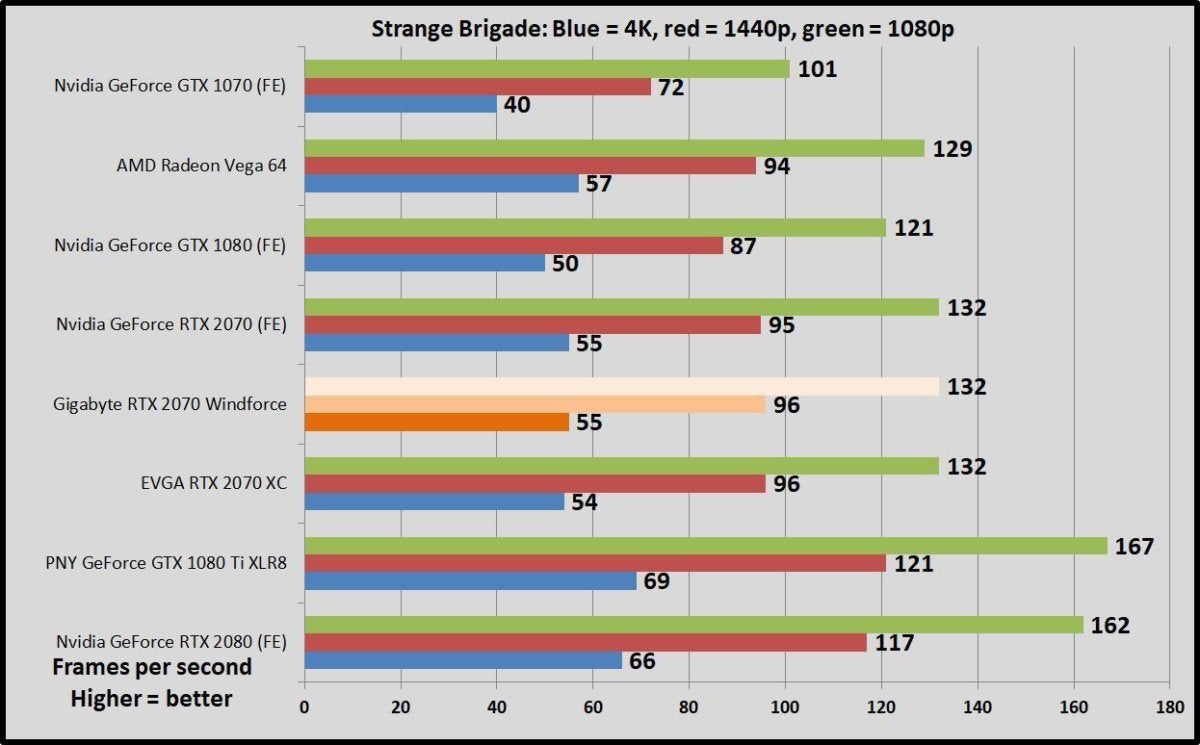 Brad Chacos/IDG
Brad Chacos/IDG Shadow of the Grave Raider
Dwarf of the Tomb Looter ($60 on Humble) concludes the reboot trilogy, and it's utterly gorgeous—even the state-of-the-art GeForce RTX 2080 Ti barely manages to median 60 fps with all the bells and whistles turned connected at 4K resolution. Square Enix optimized this gamey for DX12, and recommends DX11 only when you're victimisation older ironware surgery Windows 7, so we test with that. Shadow of the Tomb Pillager uses an enhanced reading of the Foundation garment engine that too powered Rise of the Tomb Despoiler.
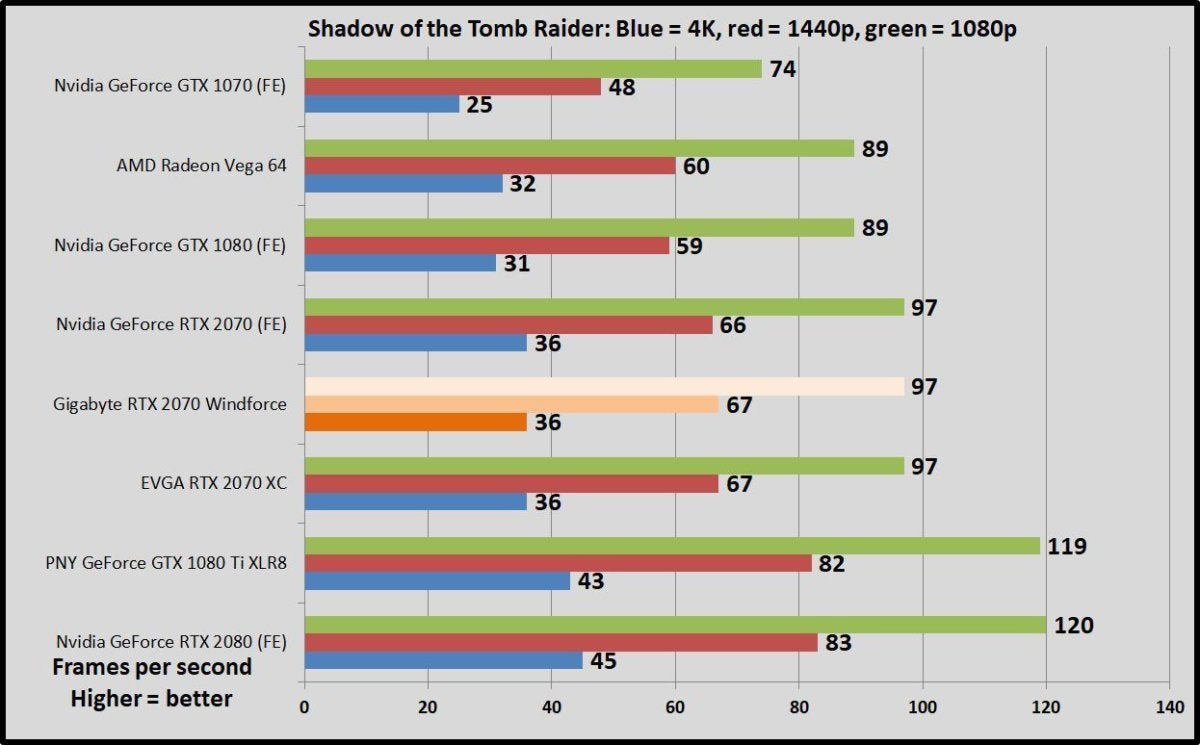 Brad Chacos/IDG
Brad Chacos/IDG Uttermost Yell 5
Finally, a DirectX 11 brave! Far Cry 5 ($60 happening Broken) is powered aside Ubisoft's long-established Dunia engine. It's just as beautiful as its predecessors, and even to a greater extent fun.
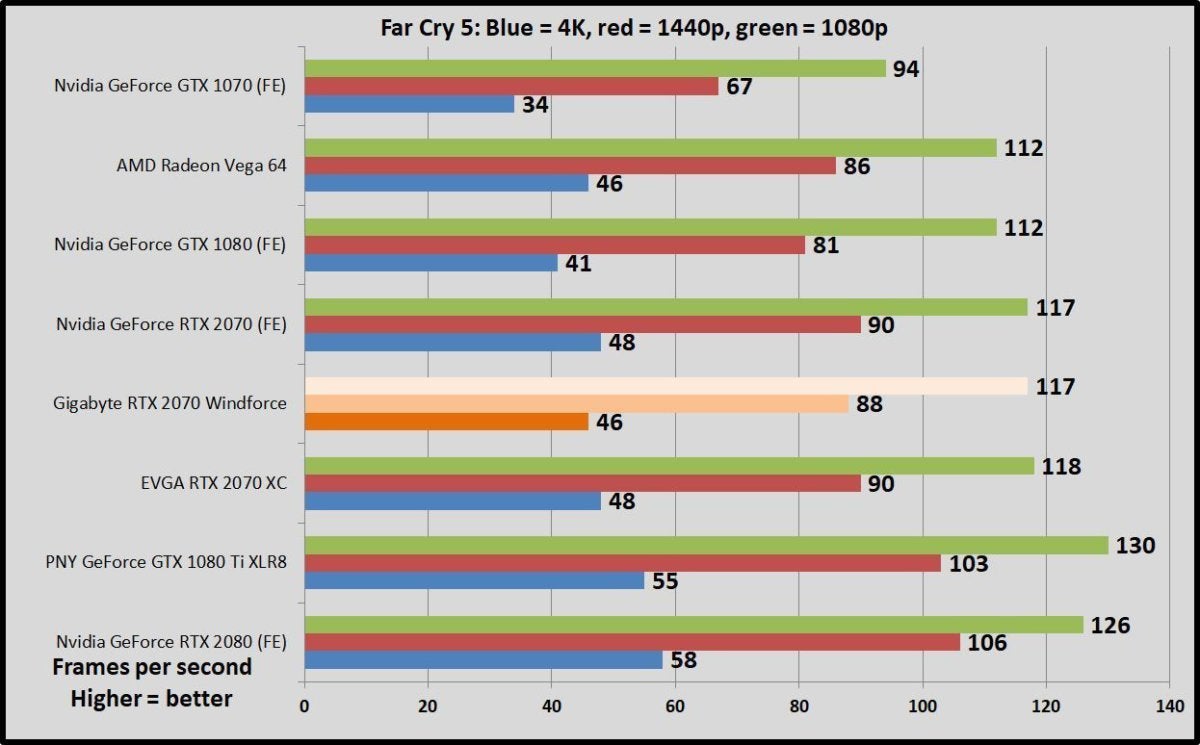 Brad Chacos/IDG
Brad Chacos/IDG Succeeding Page: Gaming benchmarks keep
Obsess Recon Wildlands
Move over, Crysis. If you crank altogether the graphics options capable 11, like we arrange for these tests, Wraith Recon Wildlands ($50 on Meek) and its AnvilNext 2.0 engine absolutely melts GPUs.
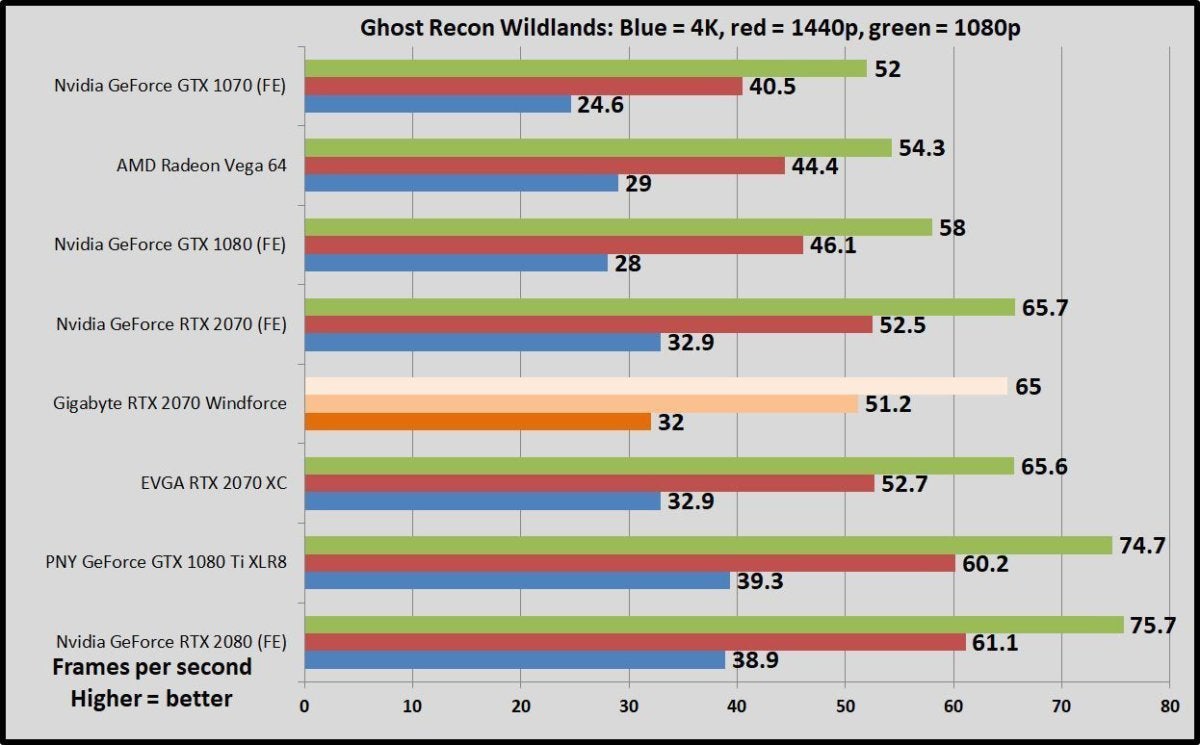 Brad Chacos/IDG
Brad Chacos/IDG Middle-worldly concern: Shadow of State of war
Middle-earth: Shadow of War ($50 along Humble) adds a strategic layer to the series' sublime core gameplay loop, adapting the Nemesis organization to let you create an army of personalised Orc commanders. It plays like a title-holder on PC, likewise, thanks to Monolith's bespoken LithTech Firebird locomotive. We use the Radical graphics preset simply drop the Shadow Quality mise en scene to High to avoid exceeding 8GB of VRAM custom.
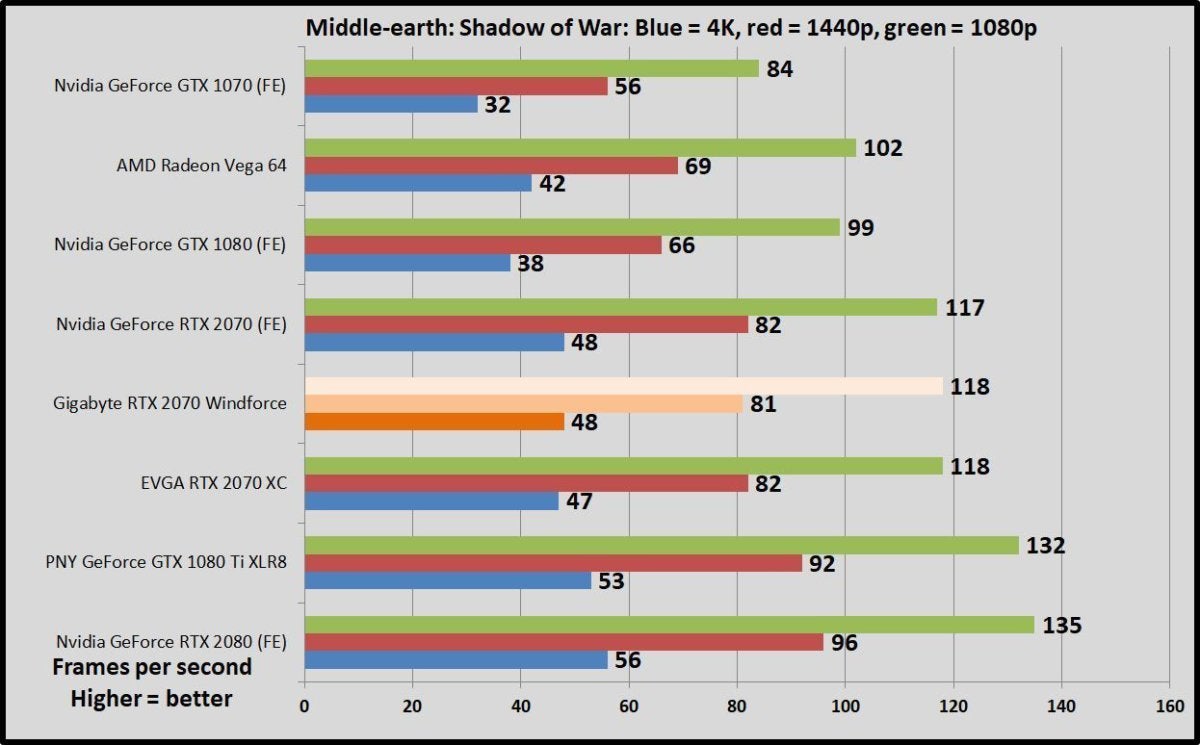 Brad Chacos/IDG
Brad Chacos/IDG F1 2018
The latest in a long line of successful games, F1 2018 ($60 connected Modest) is a benchmarking gem, supplying a open array of both written and benchmarking options—making it a much many reliable measurement than the Forza serial, which uses dynamic weather genesis. It's built on the twenty-five percent version of Codemasters' buttery-smooth Ego game locomotive. We test two laps on the Australia course, with clear skies.
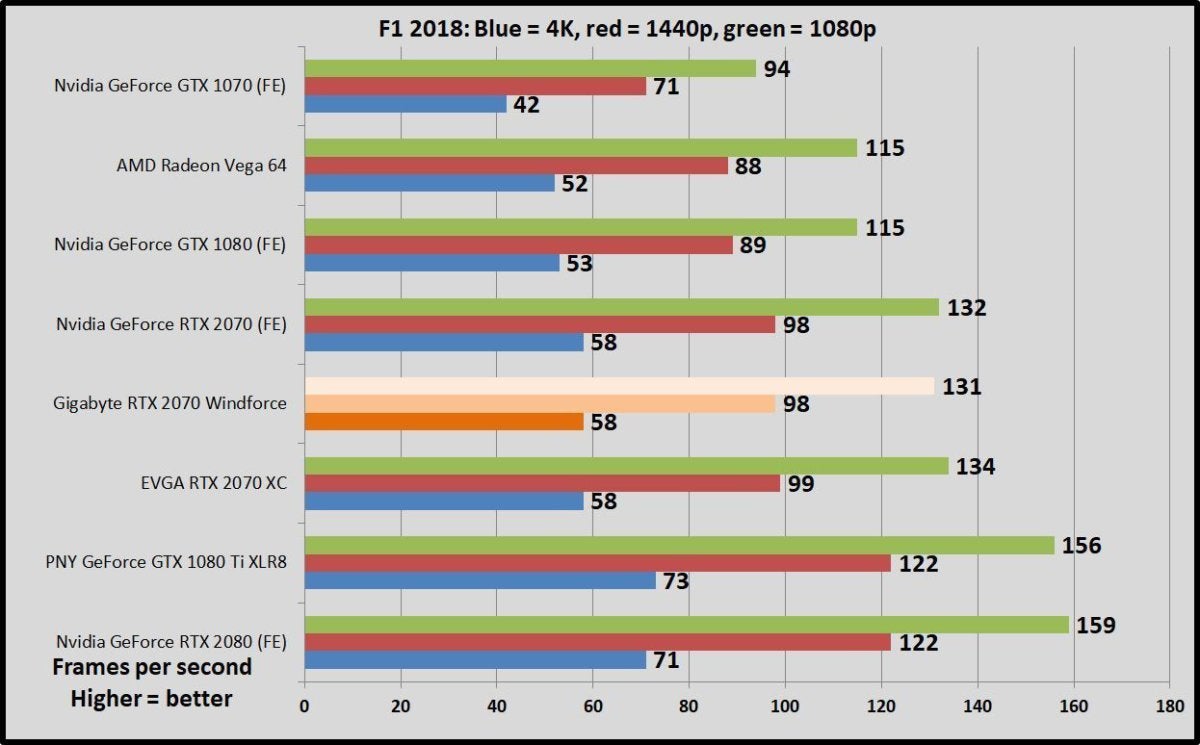 Brad Chacos/IDG
Brad Chacos/IDG Ashes of the Singularity: Escalation
Ashes of the Singularity ($40 on Humble) was one of the very starting time DX12 games, and it clay a flag-bearer for the technology to this day thanks to the extreme scalability of Oxide Games' next-gen Nitrous engine. With hundreds of units onscreen simultaneously and some serious graphics personal effects in bring, the Impractical predetermined can make graphics cards sweat. Ashes runs in some DX11 and DX12, but we only test in DX12, American Samoa it delivers the best results for both Nvidia and AMD GPUs.
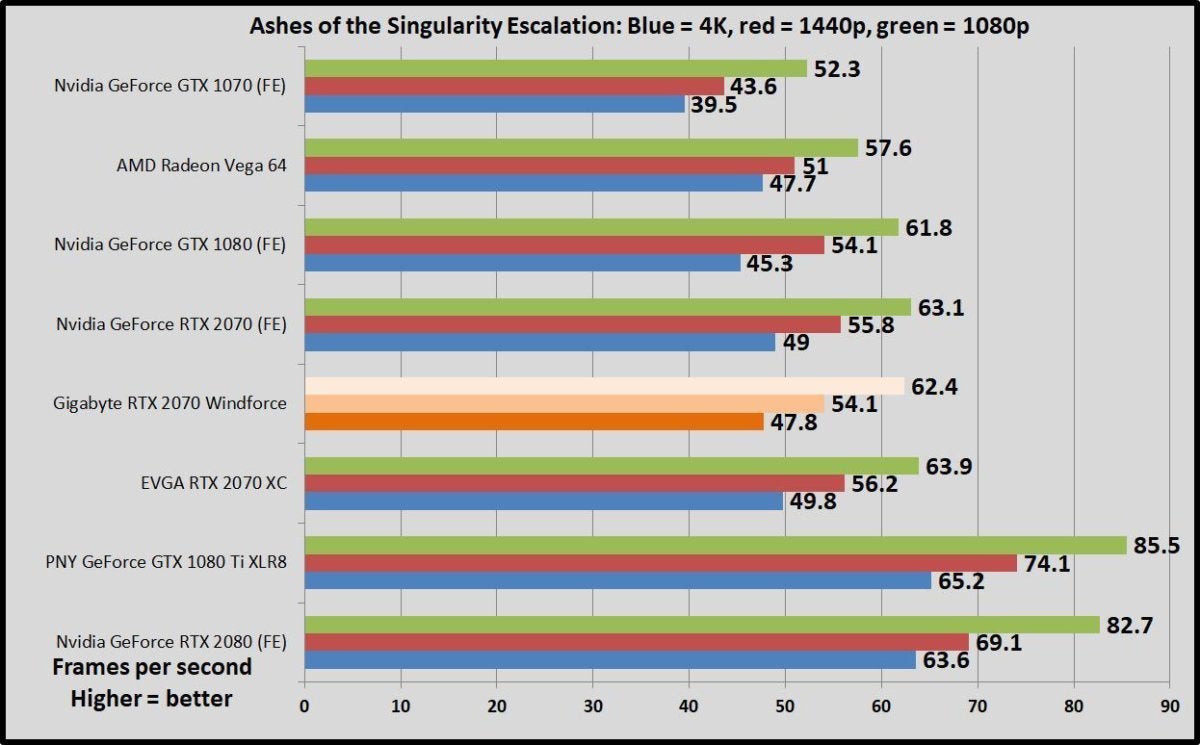 Brad Chacos/IDG
Brad Chacos/IDG Rainbow Six Beleaguering
Finally, have's take a peek at Rainbow Six Siege ($40 on Humble), a game whose audience just keeps connected growing, and one that stillness feels ilk the merely truly next-gen gun for hire after all these years. Like Ghost Recon Wildlands, this game runs on Ubisoft's AnvilNext 2.0 locomotive, but Rainbow Six Siege responds specially well to games that lean on async compute features.
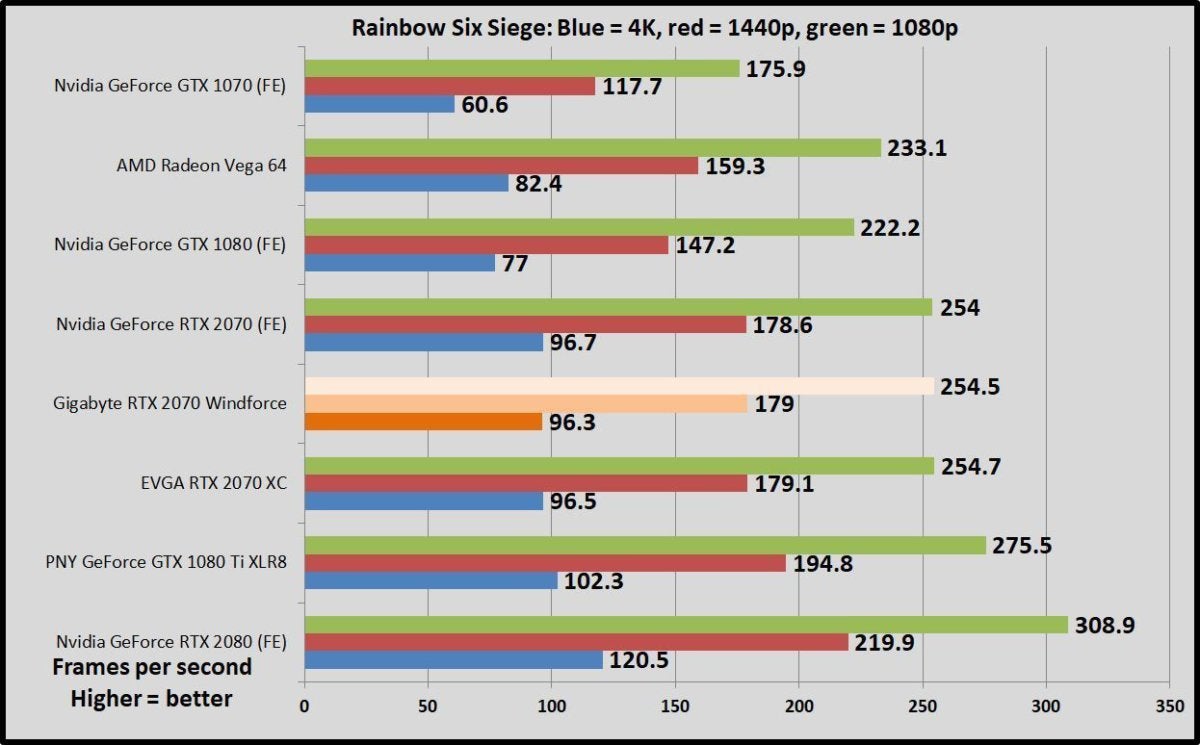 Brad Chacos/IDG
Brad Chacos/IDG Close page: Synthetic benchmarks, power draw, thermals, overclocking
Fire Mint, business leader draw, thermals, and overclocking
We also dependable the Gigabyte RTX 2070 Windforce using 3DMark's highly reputable Fire Strike synthetic benchmark. Fire Strike runs at 1080p, Flame Strike Extreme runs at 1440p, and Fire Strike Radical runs at 4K resolution. Entirely render the same scene, but with more intense graphical effects A you move up the scale, so that Distant and Ultra flavors stress GPUs even more. We record the art score to eliminate variance from the CPU.
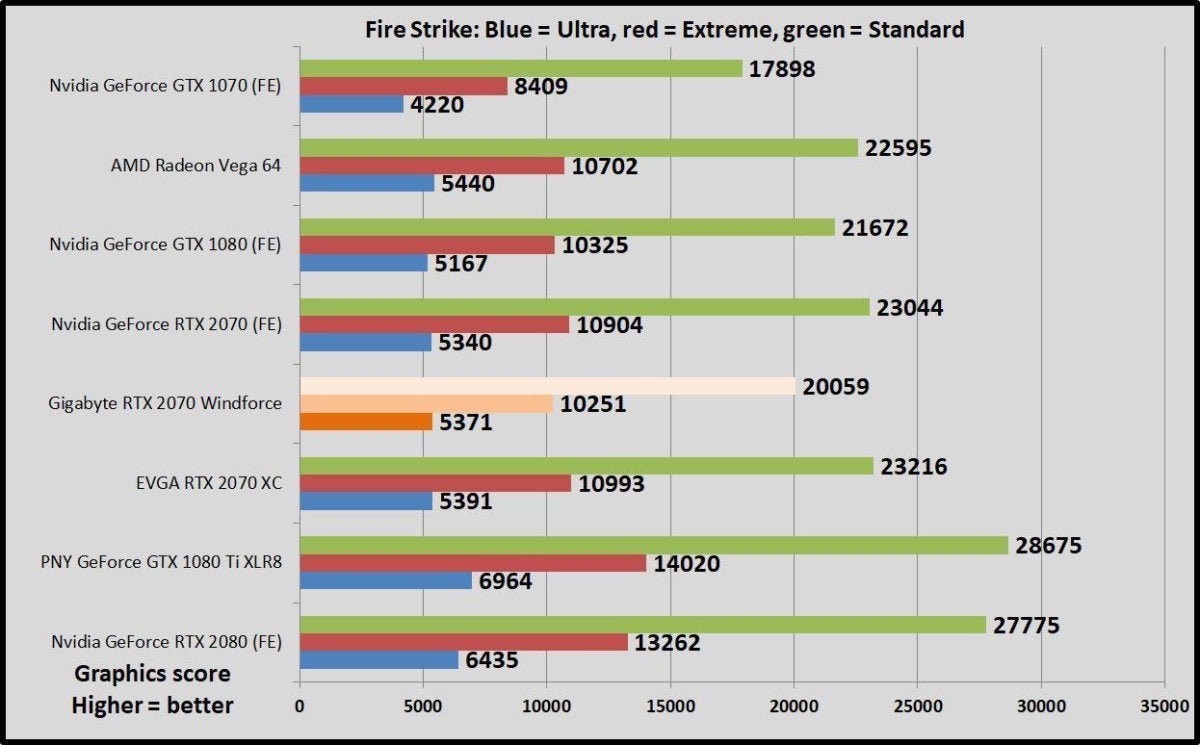 Brad Chacos/IDG
Brad Chacos/IDG All three RTX 2070 options deliver generally similar results. The Founders Edition lags slightly behind the Gigabyte Windforce in raw GPU score despite Nvidia's modest factory overclock. Maybe its less-potent cooling solution ISN't able to clutches clocks quite as high for quite as long-staple?
We try power draw by looping the F1 2018 bench mark after we've benchmarked everything else with a card, and noting the highest reading happening our Watts Up In favor meter. The initial part of the speed up, where all competing cars are onscreen simultaneously, tends to be the most demanding portion.
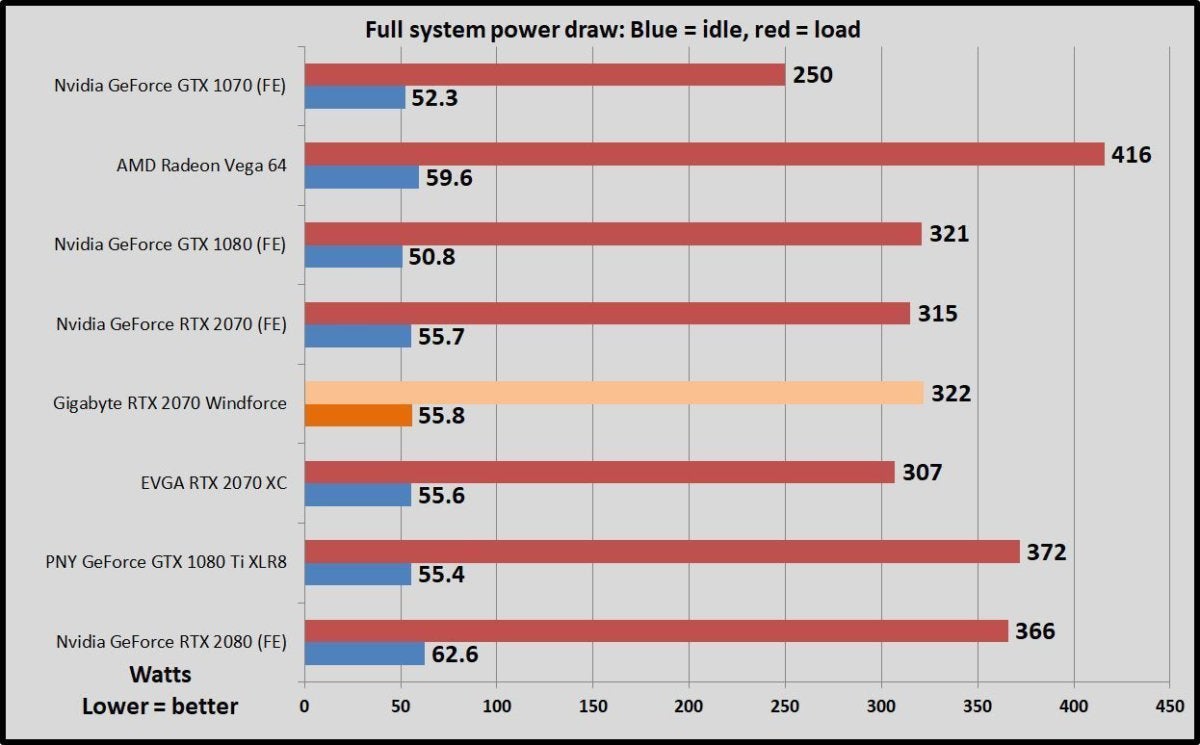 Brad Chacos/IDG
Brad Chacos/IDG The Gigabyte RTX 2070 Windforce draws about the aforesaid number of get-up-and-go as its cousins. It actually draws slimly less powerfulness than the GTX 1080 despite being measurably faster, and much inferior power than AMD's flaming-and-howling Radeon RX Lope Felix de Vega Carpio 64 reference edition.
We test thermals by leaving EVGA's Precision X1 monitoring tool unconcealed during the F1 2018 5-lap great power cast test, noting the highest maximum temperature at the end.
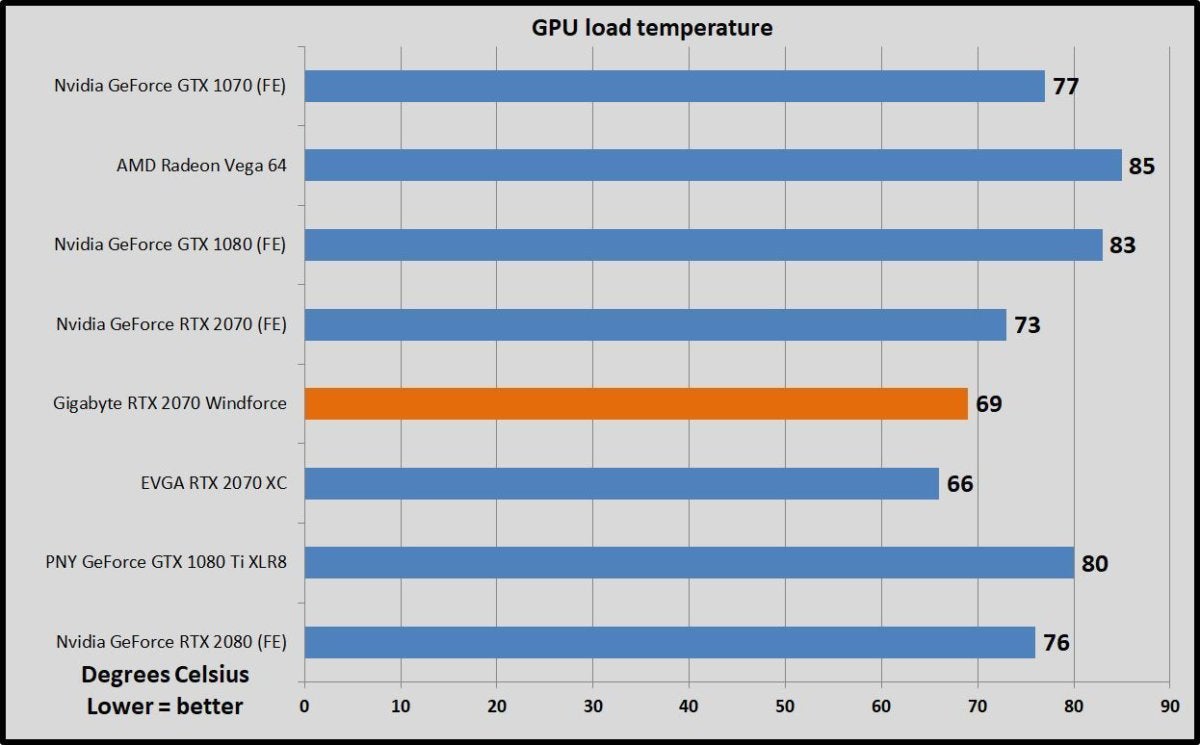 Brad Chacos/IDG
Brad Chacos/IDG The custom, triple-fan Windforce cooler along GB's wit runs slightly colder than the Founders Version's two-fold-fan solution, though non rather equally chilly as the ICX2 cooling in EVGA's RTX 2070 XC. All tierce deliver similar noise levels—you unquestionably have a go at it the lineup is running while you're gaming, but the sound isn't obnoxious or overly roaring. Gigabyte's scorecard holds an advantage when you'rhenium non play, because the RTX 2070 Windforce lets the fans go unemployed when the GPU International Relations and Security Network't under load.
Next page: Overclocking, should you buy the Gigabyte RTX 2070 Windforce?
Overclocking
As with all RTX graphics card, overclocking the Gigabyte RTX 2070 is dead-oblanceolate thanks to the new ace-click Nvidia Electronic scanner API auto-overclocking tool. Despite hitting consultation specs and an first appearance-level price tag, Gigabyte lets you step-up the Windforce's power set—the major factor property back RTX performance this coevals—up to 114 per centum, operating room more or less as much arsenic you can with Nvidia's Founders Variation. EVGA lets you crank the RTX 2070 XC adequate to a large 130 pct.
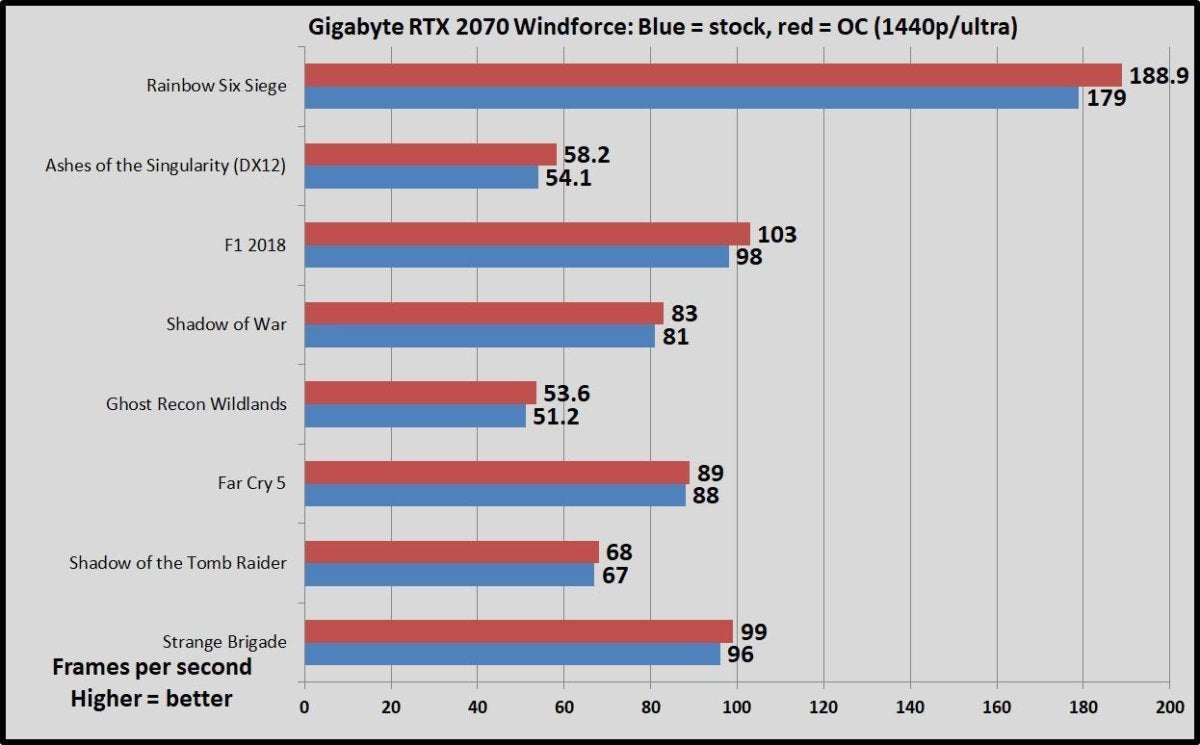 Brad Chacos/IDG
Brad Chacos/IDG Once you've maxed forbidden the power, GPU temperature, and voltage sliders and run the Scanner joyride, however, we saw about identical overclocked performance out of all deuce-ac of these RTX 2070 options. The GB Windforce's +202 score resulted in a real-world-wide encouragement clock of 1,753MHz, high from the 1,620MHz reference spec. Nvidia's GPU supercharge technology lets RTX nontextual matter cards far exceed rated boost filaree, though. Fully loaded, all three hit sustained clock speeds around the 2GHz mark in most gaming workloads—going just over in lighter scenes, and dipping just under in heavier scenes.
Should you buy the GeForce RTX 2070 Windforce?
Definitely, if you're in the market for a $500 graphics card.
The RTX 2070 dominates its $500 rivals, the GTX 1080 and Radeon RX Lope de Vega 64, delivering a double-digit averaged performance vantage against the utmost-gen GPUs, and over 20 percent more operation in games that leverage async calculate capabilities. Plus, Nvidia's modish hardware grants access to the gamy spick-and-span worlds of ray tracing and AI-enhanced gaming. Because nobelium substantial-populace games incorporate those technologies yet, however, we can't measure how well the veer-down RTX 2070 performs in those tasks compared to more expensive RTX options.
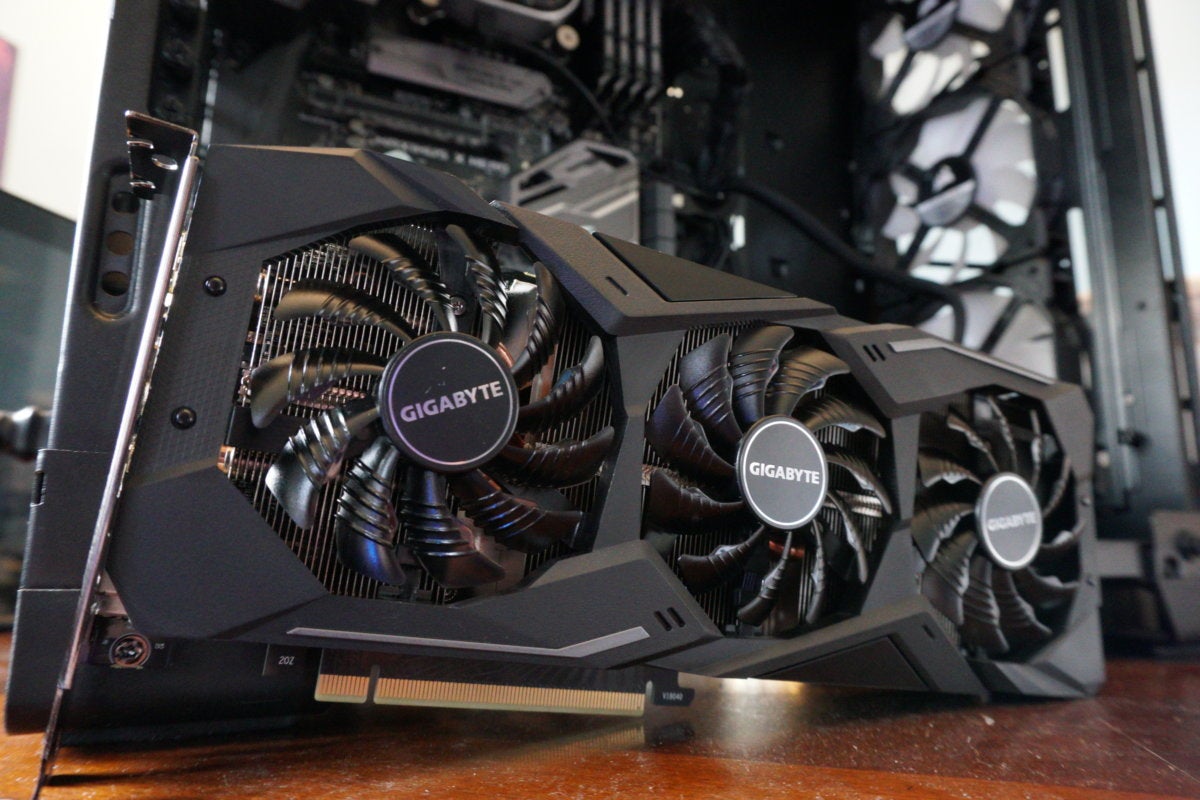 Brad Chacos/IDG
Brad Chacos/IDG The Gigabyte RTX 2070 Windforce hangs with the overclocked $550 EVGA XC and $600 Nvidia Founders Edition performance-wise, despite sticking out to stock speeds and a baseline price tag. Applying a quick and easy auto-overclock with Nvidia Scanner pushes the wag's compose rates on the far side those pricier options—though those can also be overclocked—and the triple-fan Windforce cooler runs slightly colder than Founders Version solution.
Disbursement more would receive you some nice extra features, same dual BIOSes and quieter cooling system. Nevertheless at $500 on Amazon, the Gigabyte RTX 2070 Windforce is easy to recommend. Pick it up if you're looking for a great graphics card for higher-refresh-rate 1440p gaming, or blazing-fast 1080p. Information technology's also subject of unveiling-level off 4K gambling if you're willing to turn of events some graphics options down to High. If you'rhenium conscionable looking for 1440p gaming at 60 frames per second, though, and particularly if you don't mind playing below Ultra art settings, you fundament carry through few fret aside opting for a last-gen GTX 1070 or GTX 1070 Ti alternatively.
Best Prices Today

$859.00
Note: When you buy up something after clicking links in our articles, we may make a miniature commission. Record our assort link policy for more details.
Brad Chacos spends his days dig through screen background PCs and tweeting overmuch.
Source: https://www.pcworld.com/article/402874/gigabyte-geforce-rtx-2070-windforce-review.html
Posted by: reddanstivoung.blogspot.com


0 Response to "Gigabyte GeForce RTX 2070 Windforce review: This $500 graphics card is a solid value - reddanstivoung"
Post a Comment